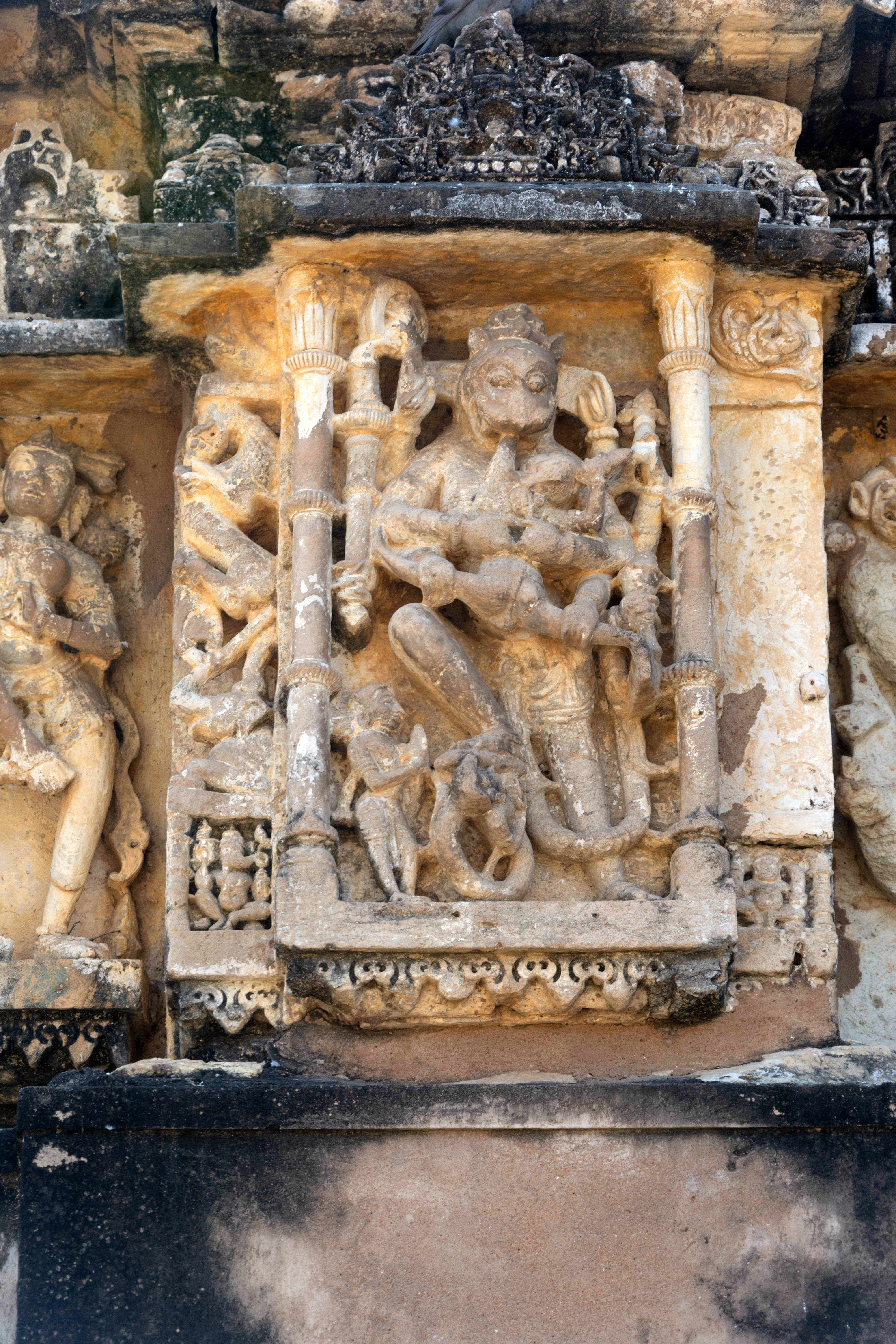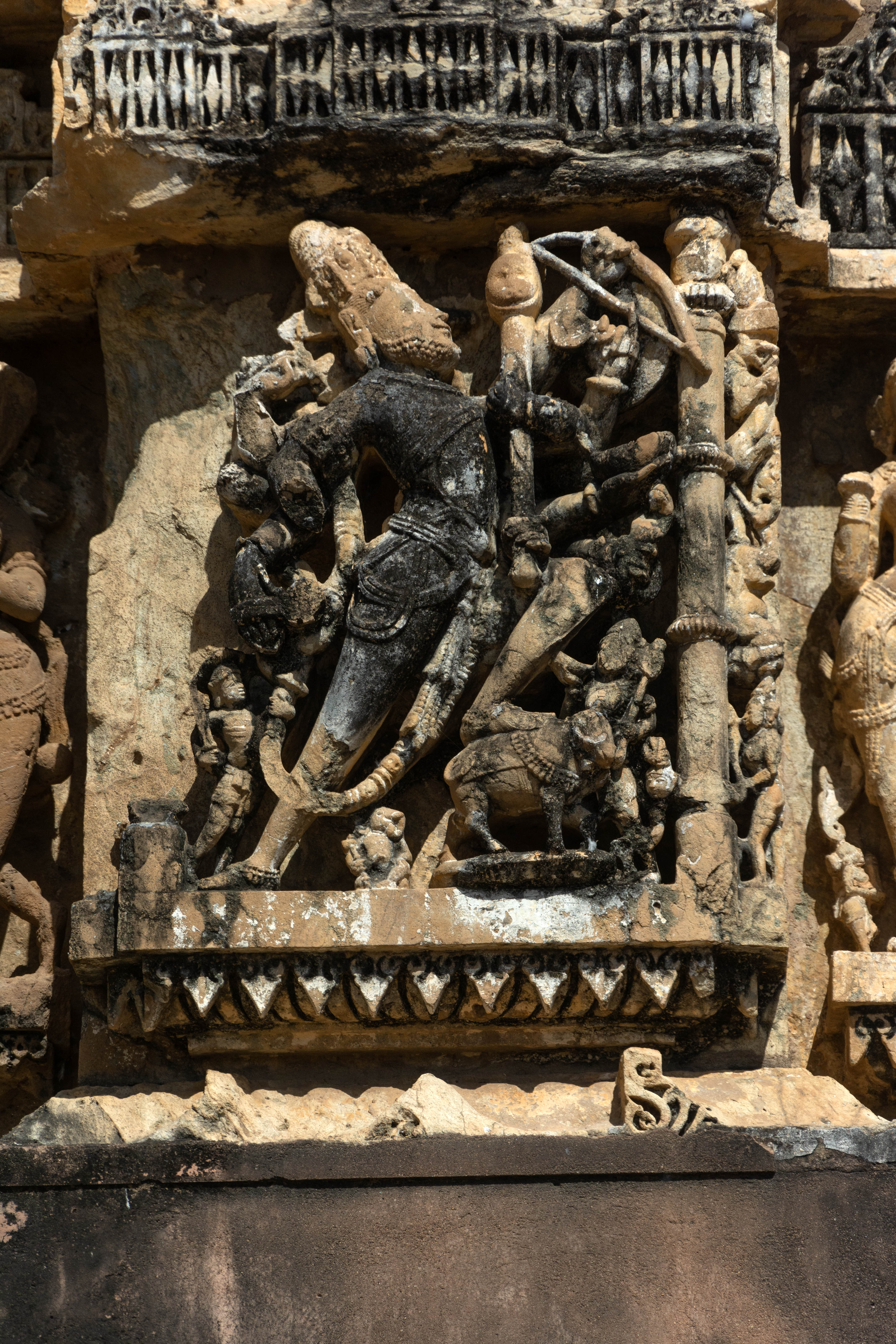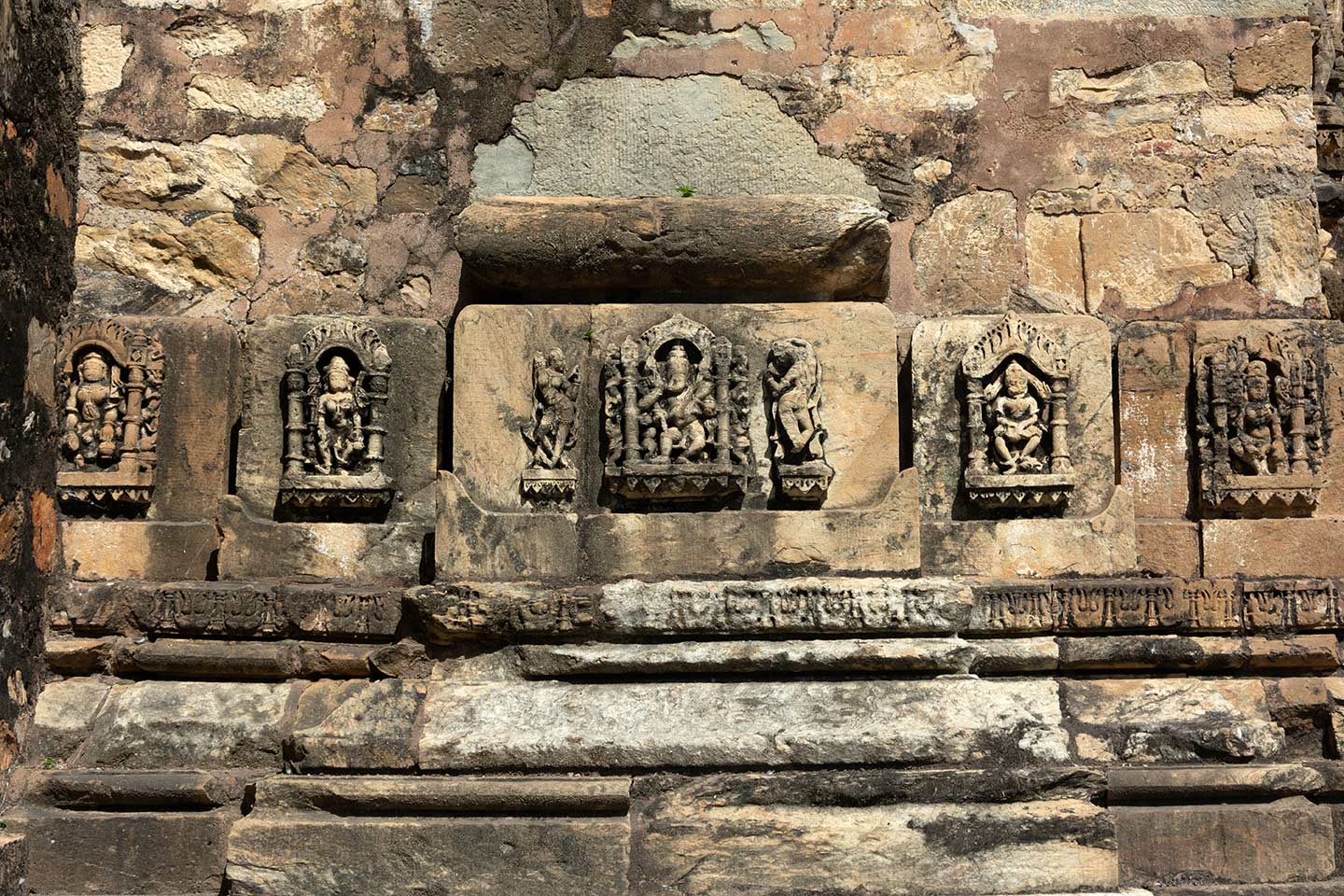Sculptural Art of Neelkanth Mahadev Temple
By Swapna Joshi
Parnagar, or Paranagara, historically known as Rajogarh or Rajyapura, is home to several temples predominantly dedicated to the Shiva and Jain religious traditions. [1] M.A. Dhaky has listed more than a dozen temples here. [2] The site is in the middle of the Sariska Tiger Reserve, which makes accessibility to the temple complex a little difficult. Other temples in this complex, except for the Neelkanth Mahadev Temple, are in utter disrepair, with only their plinths remaining. A vassal of the Pratihara dynasty ruled Rajyapura at the turn of 10th century CE. During this period, the two dominant religious traditions in the region of Rajasthan were Shaivism and Vaishnavism. [3] The sculptures on the Neelkanth Mahadev temple represent both of these religious traditions.
Neelkanth Mahadev Temple, one of the better surviving complexes in the group, has three shrines and a shared mandapa (pillared hall). Over time, the exterior of the temple has deteriorated, yet it has undergone partial restoration. The central west-facing shrine in this temple, in particular, has a profusion of sculptures on its exterior walls. The other two shrines have completely reconstructed exterior walls. In contrast to the exterior, the interiors of the temple are in much better condition, adorned with intricate carvings and detailed depictions of various figures. The temple premises also have several loose sculptural fragments. Sculptures from the Neelkanth Mahadev Temple are of fine quality and exhibit exquisite craftsmanship. This article presents the general scheme of sculptures, the dedication of temples, and the stylistic patterns of the rich sculptural art of the Neelkanth Mahadev Temple.
The temple features sculptures on its walls, the vedibandha (basal mouldings) of the main temple and its side shrines, the lintels and pillars of the mandapa, and the dvarashakhas (architraves) of its three garbhagrihas (sanctum sactorum). The sculptures include images of deities such as Vishnu, Shiva, Surya, Ganesh, Brahma, Chamunda, Varaha, Narasimha, and Bhairav, among others, along with surasundaris and apsaras (celestial damsels), dikpalas (gods of the cardinal directions), mithunas (amorous couples), and maithunas (erotic imagery). The Archaeological Survey of India (ASI) has positioned several sculptures in a storehouse located southeast of the temple. The preservation of some of these sculptures is inadequate, making it difficult to identify their depictions based on the deity's form, stance, or attributes. The loose sculptures speak to the richness of the Neelkanth Temple's original construction.
Exterior Walls of the Neelkanth Mahadev Temple
The triple-shrine temple of Neelkanth Mahadev is pancharatha (consisting of five projections) in plan and features a latina nagara shikhara (mono-spired variety). The central shrine is the primary source of sculptures along the exterior walls. On each side, the bhadras (central projections) have images of deities; the intermediary projections have depictions of surasundaris, vyala figures, mithuna-maithuna, and ascetics; and the corner projections have sculptural images of dikpalas. Several contemporary temples commonly feature this iconographic scheme. [4] For example, the Harshatmata Temple in Dausa, the Shiva Temple at the Arthuna group of temples in Banswara, and the Suswani Mata Temple of Morkhana in Bikaner all have similar iconography. [5]
The three principal projections of the walls of the central shrine in the Neelkanth Mahadev Temple have Narasimha, Harihararka (or Hariharapitamaharka), and Tripurantaka on its north, east, and south sides, respectively. The standing Narasimha, a form of Vidarna Narasimha, depicts the deity using his nails to kill the demon Hiranyapashiku (Image 1). Narasimha is the fourth incarnation on the commonly known Vishnu dashavatara lists. He killed a demon with a divine boon by which he could not be killed by any beast or human, with any weapon, and not during the day or night. The image depicts Narasimha wielding a gada (mace), chakra (discus), shankha (conch), and padma (lotus), all common attributes associated with Vishnu. Below his right leg is a figure standing in namaskara mudra (hands folded near the chest) who could be Pralhada, the son of Hiranyakashipu and an ardent devotee of Narasimha.
The Tripurantaka, an equally aghora form of Shiva, complements the ferocious form of Vishnu on the south-facing wall of the temple (Image 2). In this form, Shiva, as Tripurari, sought to destroy three demons, sons of Tara, who had captured the three cities and disrupted the world. Shiva raised his arrow to destroy all three asuras (demons) and restore the world. The Neelkanth Mahadev Temple wall depicts Tripurantaka Shiva wielding a bow and arrow in his upper left hand. Among the other attributes, the visible ones are a khatvanga (a club with a skull), kapala (skull bowl), and naga (snake), all in the right hands.
The Harihararka (or Hariharapitamaharka), a unique composite image on the exterior wall facing east, incorporates representations of Shiva, Vishnu, Surya, and plausibly Brahma into a single sculpture (Image 3). Sitting on a chariot of seven horses, the three-faced figure embodies the attributes of all these deities. In the left hand, the figure holds a chakra, a padma, a gada, and a kamandalu (pitcher) corresponding to the attributes of Surya, Vishnu, and Brahma. Regrettably, the sculpture's right hand lacks all its attributes. Such a composite image suggests a syncretic religious attitude that was prevalent during the construction of this temple.
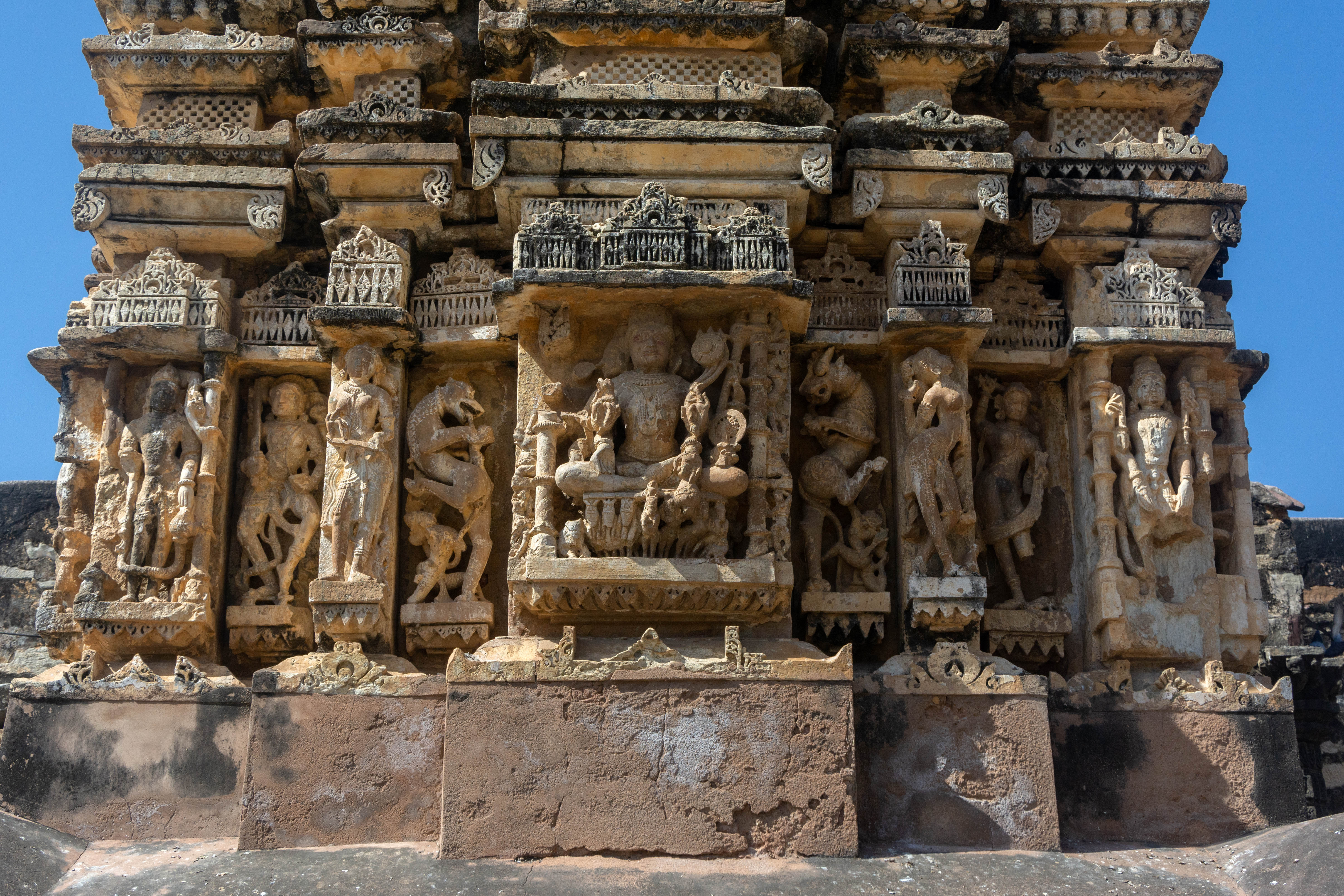
M.A. Dhaky has pointed out that the choice of the three bhadra figures, containing a Narasimha while excluding a goddess, is a peculiar iconographic scheme not generally found in other temples of this period. [6]
In addition to the main temple walls, the temple plinth's kumbha (pot-shaped) moulding is also home to sculptures. Some northern plinth sculptures remain, but most have disappeared. These include the images of Saraswati, Mahishasurmardini, and Bhairav, while several others are difficult to identify owing to erosion. Similarly, on the kumbha moulding of the south-facing wall of the same shrine, there is a depiction of Bhuvaraha, mithuna couples, and two sculptures of goddesses.
The north and south-facing side shrines in the Neelkanth Mahadev Temple have lost their exterior walls except for the basal mouldings up to the level of the kumbha moulding. The south-facing shrine has images of Ganesh, Saraswati, Shiva-Parvati, Surya, Bhairav, erotic couples, and ascetics. The north-facing shrine features images of Ganesh, Lakshmi-Vishnu, Narasimhi (the Shakti form of Narasimha), Bhuvaraha, Narasimha, and Saraswati, among others, on the south and east faces of the kumbha moulding (Image 4). The kumbha moulding of the karna prasadas (corner shrines) within the Neelkanth Mahadev Temple complex also features a strikingly similar scheme of sculptures.
Interior of the Neelkanth Mahadev Temple Complex
The temple's interiors feature sculptural representations on the lintels, dvarashakhas, and pillars. The niches above the beam of the antechamber entrance, just below the samatala vitana (flat ceiling), have sculptures of Shiva, Vishnu, and Brahma with their consorts on the east, north, and south-facing shrines, respectively. These sculptures are indicative of the original dedication of these shrines, even if the original images in the sanctums are missing. Based on iconographic depictions, it is likely that the main shrine was dedicated to Shiva (owing to the presence of a Shiva linga), while the lateral shrines would possibly have been dedicated to Vishnu and Brahma. The lintels of the dvarashakhas of each of these shrines have a row of Shiva, Vishnu, Brahma, Surya, and Chamunda images. When Shiva is in the centre, the lalatbimba (keystone of the doorframe) has an image of Nandi (Image 5). M.A. Dhaky proposed the construction of the Neelkanth Mahadev Temple as a tripurush devalaya, a temple honouring Brahma, Vishnu, and Shiv. [7] He has noted that Temple No. 7 in the Neelkanth Mahadev complex, also a triple shrine temple, could likely also have been a temple built for tripurush.
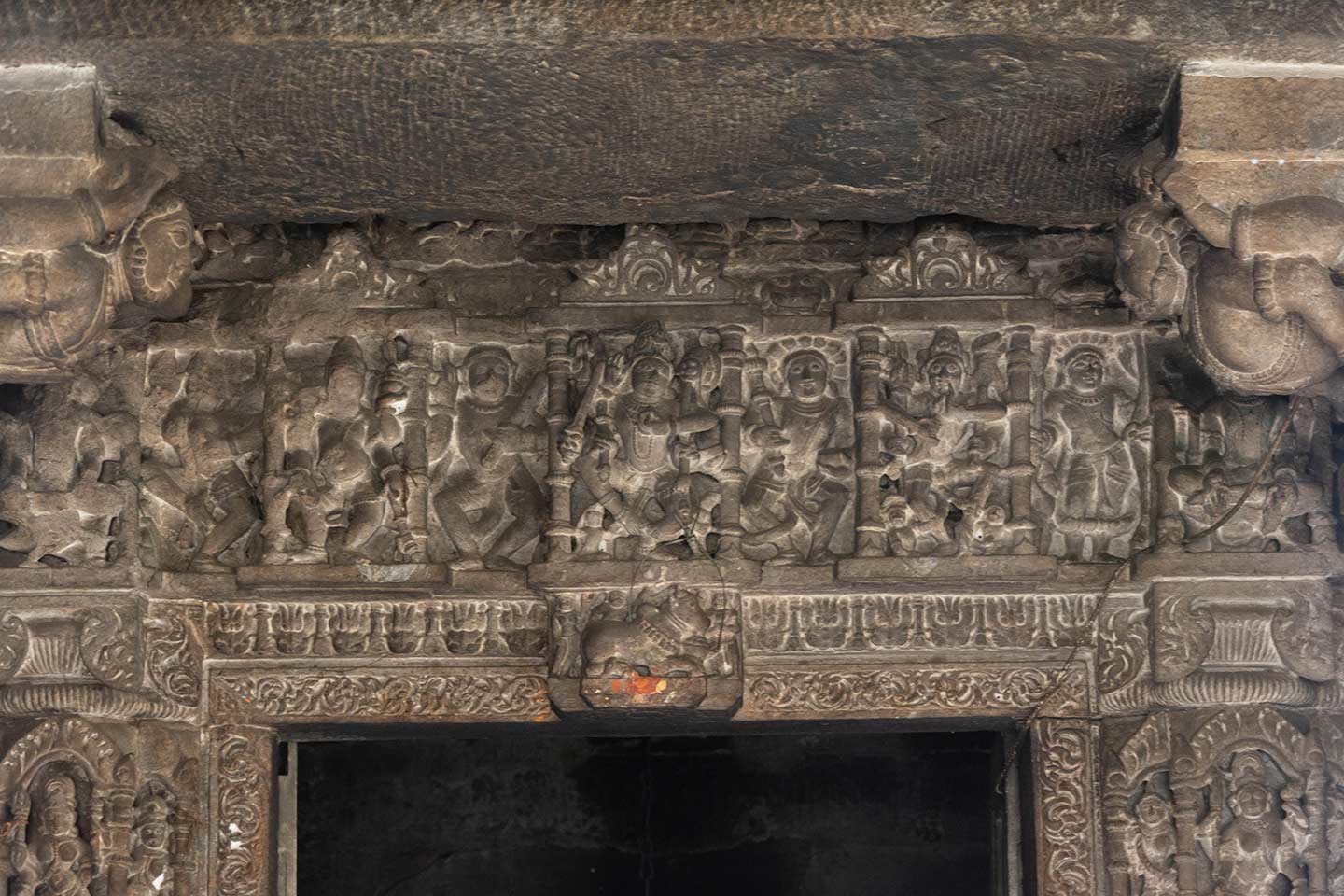
One type of pillar in the temple's mandapa has surasundaris carved on its shaft (Image 6). On the cylindrical pillar, the sculptures are on the lower half of the shaft, while the upper part has geometric patterns and maladhara figures (males holding garlands). The brackets above the chatushki feature designs reminiscent of surasundaris. All the diminishing slabs of the ceilings feature friezes of ganas (attendants), erotic couples, and human and animal figures.

Scattered Sculptures around the Neelkanth Mahadev Temple
The Neelkanth Mahadev Temple is home to several loose sculptures. Notable among these are the sculptures of Padmavati, Yoga Vishnu, Ganesha, dikpalas, and surasundaris (Image 7). These sculptures were likely included in the jangha (wall) of the temple's lateral shrines. On the wall projection fragment, Dhaky identified a sculpture of Padmavati, framed in a niche. [8] Located north of the main temple, the sculpture has eroded further since Dhaky first documented it. Along the northern boundary of the temple is a peculiar sculpture of Vishnu in padmasana (lotus pedestal) yoga posture. The sculpture depicts Vishnu holding a shankha and a chakra in his lower left and upper left hands, respectively, with his right hands broken. On the left side, a Vaishnava attendant flanks the image. A short distance from the Neelkanth Mahadev Temple to the east, near the baoli (stepwell), is a beautiful sculpture of Shiva-Parvati in a sitting posture. The pedestal features carved images of Nandi and Ganesha. It is plausible that Kartikeya was also once part of the composition, but is now missing.
Besides the Neelkanth Mahadev Temple, the complex has Jain and Shiva temples with sculptures. Most of these sculptures have been removed from their original locations and are scattered around the temple premises. The profusion of Shiva-affiliated sculptures indicates the strong influence of Shaivism in the Paranagara region, along with a syncretic attitude towards various sectarian practices. This also includes the colossal figure Shantinatha Tirthankara, whose presence underscores the region's stronghold of Jainism. Since the temples of the Neelkanth Mahadev Temple complex are not in the best-preserved state, these sculptures aid in analysing the prevalent religious traditions, sectarian choices of the patrons, and the religious inclinations of society.
Footnotes:
[1] Joshi and Deva, Inventory of Monuments, 25.
[2] Dhaky, Beginnings of Medieval Idiom, 348–60.
[3] Vashishtha, Sculptural Traditions of Rajasthan, 11.
[4] Hooja, Icons, Artefacts and Interpretations of the Past, 14.
[5] Vashishtha, 9–10.
[6] Dhaky, 357.
[7] Dhaky, 358–59.
[8] Dhaky, 361.
Bibliography
Dhaky, M.A., ed. Encyclopaedia of Indian Temple Architecture—North India: Beginnings of Medieval Idiom c. AD 900–1000. 2 Volumes. New Delhi: American Institute of Indian Studies and Indira Gandhi National Centre for the Arts, 1998.
Hooja, Rima. ‘Icons, Artefacts and Interpretations of the Past: Early Hinduism in Rajasthan.’ In World Archaeology 36, no. 3 (2004): 360–77. https://www.jstor.org/stable/4128337.
Joshi, Jagat Pati and Krishna Deva, eds. Inventory of Monuments and Sites of National Importance, Volume 2, Part 1 Jaipur Circle, India: Archaeological Survey of India, 1999.
Vashishtha, Neelima. Sculptural Traditions of Rajasthan, ca. 800–1000 A.D. Jaipur: Publication Scheme, 1989.
